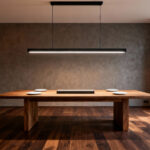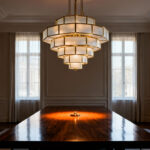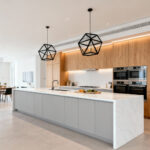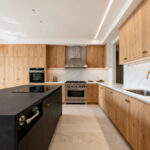You just signed the lease. You’ve got the keys in your hand, and you walk into your new apartment living room. You see… potential. And also, a lot of beige. A boxy shape. Weirdly placed outlets. That one, single, harsh overhead light. It’s a space that doesn’t feel like you yet, and honestly, that blandness can be a little draining.
The thing is, transforming that generic box into a personal sanctuary has less to do with a huge budget and more to do with understanding how we, as humans, react to the spaces we inhabit. Your living room is the heart of your home—it’s where you decompress, connect with friends, and just… be. When that space is cluttered or soulless, it quietly chips away at your peace of mind. I once had a client who felt a constant, low-grade anxiety at home and couldn’t figure out why. Turns out, the disarray and lack of personal touches were sending his brain constant stress signals.
So, let’s change that. Forget overwhelming renovations. We’re going to walk through some powerful, renter-friendly ideas that are all about shaping your environment to support you. From the ground up.
1. Plan Your Layout for Flow, Not Just Looks
Before you even think about paint swatches or that cool sofa you saw online, we need to talk about flow. It’s the invisible architecture of your room. So many people make the same initial mistake: they push all their furniture against the walls, thinking it will make the room feel bigger. It doesn’t. It creates what designers call a “dead zone” in the middle, a kind of empty, unused void. Frankly, it makes a room feel like a waiting room.

Instead, I want you to start thinking like a city planner. Grab some graph paper (old school, I know, but it works!) or a free online tool, and sketch out your room. Watch how you naturally walk through it. Where are the pathways? The goal is to create easy-to-navigate routes from the door to the sofa, to the window. You do this by “floating” your furniture. Pull that sofa away from the wall just a few inches. Group your seating around a central point. You’re not just arranging furniture; you’re creating invisible currents that make the room feel effortless and functional. A room with good flow is calming because your brain doesn’t have to constantly solve the tiny problem of how to get from point A to point B.
Now that we’ve got the bones of the room working for you, let’s add the first layer of personality and mood. This is where the real magic begins.
2. Pick a Cohesive Color Palette for Instant Harmony
Color is, without a doubt, the most powerful tool for shaping the emotional experience of a space. It’s also where I see the most fear and indecision. People are so worried about getting it “wrong” that they default to white or gray, which can sometimes feel more sterile than serene. But what if you saw color not as a risk, but as a recipe?

Here’s what’s interesting: our reactions to color are deeply wired. We find blues and greens calming because for millennia, they’ve signaled water and lush landscapes—sources of life and safety. Earthy tones make us feel grounded because, well, they connect us to the ground. That’s the ‘why’ behind it all. A simple framework I give my clients is the 60-30-10 rule. Think of it as your scaffolding: 60% of your room is your main color (walls), 30% is your secondary color (upholstery, curtains), and 10% is your accent (art, pillows). Find a rug or a piece of art you absolutely love and pull your three colors from there. It’s a nearly foolproof way to start. But stay with me here, this next part’s important. You have to pay attention to undertones. A cool, blue-based gray on the walls and a warm, yellow-based beige sofa will always feel subtly “off,” creating a visual friction you can’t quite name. Testing your colors together in your room’s light is non-negotiable.
With our palette established, we can start choosing the bigger pieces that will bring that color to life, while also solving one of an apartment’s biggest headaches: space.
3. Choose Multi-Functional Furniture to Maximize Space
Let’s be honest, apartment living rooms are often asked to be a movie theater, a home office, a dining room, and a place to just crash. To do all that without descending into chaos, your furniture has to work smarter, not harder. Multi-functional furniture isn’t just a trend; it’s a survival tactic for small-space living.

This means looking for pieces that do more than one job. A coffee table with a lift-top that becomes a desk. An ottoman that opens up for storing your blankets (and the mess you need to hide before guests arrive). A sectional with chaise lounges that are secretly storage chests. But here’s the thing: don’t just buy something because it has a hidden feature. Test it. Is that lift-top wobbly and annoying to pull up? You won’t use it. Is the storage bench so heavy you can barely open it? It’s just a bench. The function needs to feel effortless to actually be useful. Measure twice, buy once, and prioritize the pieces that solve your specific problems.
Once your hardworking furniture is in place, we need to ground it so it doesn’t feel like it’s just floating in the room. That’s where rugs come in.
4. Define Room Zones with Strategic Area Rug Placement
An area rug is more than a soft spot for your feet. In an open-plan apartment or studio, it’s an island of purpose. It’s the visual cue that says, “This is the conversation area,” or “This little corner is for reading.” It draws an invisible boundary that creates a powerful psychological sense of order. Without a rug, furniture can look a bit lost, like little boats adrift in a sea of hardwood or carpet.

The single biggest mistake I see people make is choosing a rug that’s too small. A little “postage stamp” rug that only sits under the coffee table makes the whole arrangement feel disconnected and, counterintuitively, makes the room look smaller. Here’s the rule of thumb: your rug should be large enough that at least the front legs of your sofa and any chairs are sitting on it. This physically and visually ties the whole conversation area together into one cohesive unit. It anchors everything. And don’t be afraid to use a round rug to soften a boxy room or layer a smaller, funkier rug over a larger neutral one for extra texture and personality.
Rugs define the floor plane, but to truly change the feeling of a room, you have to look up.
5. Master Layered Lighting for a Cozy Ambiance
If you’re still relying on that one harsh overhead light that came with your apartment, you’re living in an “interrogation room.” It’s the fastest way to make a space feel flat, sterile, and unwelcoming. Layered lighting is the answer, and it’s one of the most dramatic, non-permanent changes you can make.

Think of lighting in three layers. First, Ambient: this is your general, room-filling light. Instead of the overhead monster, use a couple of floor lamps or table lamps to create a warm, diffuse glow. Second, Task: this is your focused light for specific activities. A stylish reading lamp next to your favorite chair, or an adjustable light by your makeshift desk area. It’s practical, but it also creates cozy pools of light. Third, Accent: this is the fun stuff. An uplight behind a big plant to create dramatic shadows, or a small picture light over your favorite piece of art. The key is to have multiple sources at different heights, all putting out a warm light (look for bulbs around 2700K). This mix gives you depth, warmth, and the flexibility to change the room’s entire mood with the flick of a switch.
Now that we have light under control, let’s turn our attention to the sources of natural light—the windows.
6. Pick Curtains to Control Light and Boost Privacy
Window treatments are the unsung heroes of apartment decor. They’re not just there to look pretty; they’re a functional powerhouse. They control light, offer crucial privacy from that building across the way, muffle street noise, and can even help with your heating bill. This is your chance to really take control of your environment.

This is all about a magic trick for the eyes. To make your windows (and your room) feel bigger and grander, hang your curtain rod high and wide. I mean 4-6 inches above the window frame, and extend it 6-10 inches beyond the frame on each side. This does two things: it draws the eye upward, creating an illusion of height, and it allows you to pull the curtains completely clear of the window, maximizing the natural light you let in. For fabric, think about your needs. Sheer linen can give you daytime privacy while letting light filter through. For a bedroom-adjacent living room, a thicker material with a blackout lining might be a lifesaver. Layering sheers with heavier curtains on a double rod gives you the best of both worlds.
With your walls now framed beautifully, it’s time to fill them with things that matter to you.
7. Hang Wall Art at the Perfect Eye Level
You’ve got a piece of art you love, and you want to hang it. So you eyeball it, put a nail in the wall, and… it just looks a little… off. There’s a reason for that. Hanging art is a science as much as an art, and there’s a secret gallery and museum professionals use that instantly makes a room look more polished.

It’s the 57-inch rule. The center of your piece of art (or the center of a gallery wall grouping) should be 57 inches from the floor. Why? Because this is the average human eye level. It means you’re looking at the art, not up or down to it. It feels balanced and comfortable. The only time you break this rule is when you’re hanging art above furniture. In that case, the bottom of the frame should be about 6-8 inches above the back of the sofa or console table. This visually connects the two pieces. Grab a tape measure. It takes an extra minute, but it makes all the difference between a room that looks accidental and one that looks intentional.
Art fills your walls with personality, but another wall-hanging item can actually change the perceived dimensions of your space.
8. Install Mirrors to Visually Expand Small Spaces
Want to bend the laws of physics in your apartment? Use a mirror. It’s the oldest and most effective trick in the book for making a small, dark room feel larger and brighter. A mirror is basically a window you can place anywhere you want. It reflects light, bounces it around the room, and creates an illusion of depth that can be truly astonishing.

The key is strategic placement. A big mirror opposite your main window will effectively double your natural light. But here’s a word of caution: a mirror is an amplifier. Be careful what you’re reflecting. If you hang it opposite a cluttered corner or a boring blank wall, you’re just doubling the chaos or the boredom. Position it to reflect something beautiful—a view out the window, a favorite piece of art, or a nicely styled corner. A large, floor-leaning mirror can make a room feel dramatically taller, while a wide, horizontal mirror can make a narrow room feel more expansive.
Speaking of amplifying beautiful things, what if your wall itself was the beautiful thing?
9. Use Peel-and-Stick Wallpaper for a Temporary Accent
For so long, renters were stuck with “landlord beige.” The fear of losing your security deposit meant bold walls were out of the question. Not anymore. Removable, peel-and-stick wallpaper is, frankly, the renter’s best friend. It lets you create a dramatic accent wall, add a splash of pattern to a boring nook, or even line the back of a bookcase without any long-term commitment.

The trick to making it look professional lies in the prep. You need a clean, smooth wall. Wipe it down and let it dry completely. When you apply it, go slow. Use a credit card or a plastic smoother to push out bubbles from the center to the edges as you go. And my most important piece of advice: order a little extra for mistakes, and before you do the whole wall, test a small piece in an inconspicuous spot (like behind where the sofa will go) for a week or two. That way, you can see how it adheres and how easily it comes off, giving you total peace of mind.
Once your backdrop is set, it’s time to soften the edges and make the room feel truly comfortable.
10. Layer Textures with Pillows and Throws for Comfort
A room can follow all the design “rules” and still feel cold and uninviting. The missing ingredient? Texture. As humans, we have a deep psychological need for tactile comfort. Think about why you love a favorite old sweater or the feeling of a soft blanket. That’s the feeling we want to bring into your living room.

This is about creating a sensory feast. Don’t just use all cotton pillows. Mix it up. Combine the cool, smooth slip of a velvet cushion with the nubby warmth of a chunky knit throw. Add a faux fur pillow, a structured linen one, and maybe even something with leather or embroidery. You’re aiming for a mix that’s visually interesting and physically begs to be touched. Mix up your pillow sizes, too—a couple of large squares in the back, some standard ones, and a rectangular lumbar pillow in front creates a much more curated and plush look than a row of identical cushions. And drape your throws casually. It signals that this is a space for living in, not just looking at.
Texture brings softness, but to bring actual life into your space, you need something that grows.
11. Brighten Your Space with Easy-Care Indoor Plants
Nothing makes a space feel more alive, more cared for, than plants. They bring a dose of nature indoors, which our brains are hard-wired to respond to. Studies on biophilia—our innate connection to the natural world—show that having plants around can genuinely reduce stress and improve our mood. They clean the air, add vibrant color, and bring an organic, sculptural element to your decor.

The key to success is to stop buying plants based on looks alone and start choosing them based on your lifestyle and your light. Got a dark corner and a bad track record? Get a Snake Plant or a ZZ Plant; they thrive on neglect. Want something that trails beautifully off a shelf? A Pothos is your go-to. I tell my clients to be honest with themselves: are you a daily waterer or a “oops, it’s been two weeks” kind of person? Choose a plant that matches your personality. Group them at different heights to create a little green vignette that feels lush and full.
Plants bring good vibes, but we also have to deal with the stuff that brings bad vibes: clutter.
12. Find Stylish Storage Solutions to Hide Clutter
Clutter isn’t just a mess; it’s a pile of postponed decisions. And in a small apartment, it can take over your life and your mind, making it impossible to relax. The best designs are rendered useless by a tidal wave of everyday stuff. So, we need to get clever with storage that looks so good, it just feels like part of the decor.

Think of it as “hiding the ugly” and “displaying the beautiful.” For all the random stuff—chargers, remotes, mail, coasters—you want closed storage. This is where those storage ottomans, media consoles with solid doors, and decorative boxes on shelves become your best friends. They contain the chaos. Open shelving, on the other hand, is for curated displays. Your favorite books, a beautiful vase, a treasured object. By giving everything a designated home, you stop the clutter before it starts. The goal is to have surfaces that are mostly clear, which gives your mind—and your eyes—a place to rest.
Once the clutter is contained, you have room to display the things that really matter.
13. Build a Gallery Wall That Shows Your Personality
A blank wall is a blank canvas. And nothing fills it with more soul and story than a gallery wall. This is your personal museum. It’s a chance to surround yourself with what you love—art prints, personal photos, postcards from travels, concert tickets, even interesting textiles or small mirrors. It’s the single most effective way to make a temporary rental space feel permanently yours.

The secret to a great gallery wall isn’t a bunch of matching frames from a big-box store. It’s the mix. Curation is everything. Start by laying everything out on the floor. Play with arrangements, mixing different frame sizes, colors, and styles. Look for a common thread—maybe it’s a color that appears in several pieces, or a common theme—to tie it all together. A pro tip: cut out paper templates the size of your frames and tape them to the wall first. You can move them around endlessly without making a single nail hole until you have an arrangement you love.
A gallery wall tells a broad story, but some of our most treasured objects deserve a more focused spotlight.
14. Display Personal Photos and Collectibles Thoughtfully
This is different from a gallery wall. This is about elevating your most meaningful objects and memories from just “stuff” into moments of beauty. It’s so easy to fall into the “fridge door effect,” where photos and mementos are just kind of stuck everywhere. But a little bit of curation transforms them.

Instead of a dozen photos in mismatched frames scattered on a surface, try grouping them. Use frames that are all the same color (even if they’re different styles) for an instant, cohesive look. Create a small vignette on a shelf: a framed photo of your grandparents next to your grandfather’s old camera and a stack of books you love. You’re creating a story. This thoughtful grouping tells your brain that these items are important and cherished, which deepens your emotional connection to your home. It’s an act of love for your memories.
As you display more of what you love, you might find yourself running out of surface space. It’s time to think up.
15. Maximize Vertical Space with Tall, Slim Shelving
In any apartment, floor space is gold. So why do we let all that vertical real estate on our walls go to waste? When you can’t build out, build up. Tall, slim shelving units, often called ladder or etagere shelves, are a game-changer. They draw the eye upward, creating a powerful illusion of higher ceilings and a more spacious room.

Look for shelving that’s tall but has a narrow footprint. It gives you a ton of storage and display space without eating up valuable square footage. And please, for the love of all that is good, anchor it to the wall. Seriously. It’s a simple safety step that prevents a heartbreaking and dangerous accident, especially if you have pets or kids. Style your shelves with a mix of books (stack some vertically, some horizontally), plants, and those decorative storage boxes we talked about to hide the less-than-beautiful essentials. An open-backed shelf is also a great choice because it lets your wall color show through, making it feel less heavy and bulky in the room.
Shelves take care of the vertical surfaces, but the horizontal heart of the room is your coffee table. Let’s make it beautiful.
16. Style Your Coffee Table for Looks and Utility
Your coffee table is the anchor of your living room, the center of gravity for your seating area. Leaving it bare can feel stark, but loading it up with clutter makes the whole room feel messy. The goal is to create a small, curated “landscape” that’s both beautiful and functional. Because a coffee table isn’t a museum pedestal; it’s where you put your feet up and your drink down.

Start with a tray. This is the single best trick for coffee table styling. It corrals all your small items—remotes, coasters, a candle—into one tidy zone. Then, think in threes and vary your height. Our brains find groupings of three more dynamic and appealing than even numbers. Try a stack of a few beautiful books (height), a small plant or vase of flowers (organic shape), and a unique decorative object (personality). This leaves plenty of room for your laptop or a bowl of popcorn, but the overall effect is intentional and stylish.
Now, for those on a tighter budget, you don’t need to buy all these finishing touches. You can make them.
17. Create Unique Decor with Budget-Friendly DIYs
There’s a special kind of pride that comes from pointing to something in your home and saying, “I made that.” DIY isn’t just about saving money; it’s about infusing a space with your own energy and creativity. It’s about creating a one-of-a-kind piece that perfectly fits your style and your space.

You don’t have to be a master woodworker. Start small. Find a boring vase at a thrift store and give it a cool new finish with textured spray paint. Sew a new cover for a pillow out of a fabric you love. Find a plain wooden frame and embellish it. The internet is a universe of tutorials. A simple project that you complete successfully builds confidence and makes your home feel that much more personal. It’s the antidote to cookie-cutter design.
We’ve covered all the visual elements, but there’s one more powerful, invisible layer to creating a welcoming atmosphere.
18. Add an Inviting Atmosphere with Scented Candles or Diffusers
Scent is the most primal of our senses, and it’s directly linked to memory and emotion. It’s the unspoken language of a room. You can have the most beautifully decorated space, but if it smells stale, it just won’t feel right. Conversely, a carefully chosen fragrance can make a space feel clean, cozy, or energizing.

The key is subtlety. You want your home to have a signature scent, not an olfactory assault. A reed diffuser is great for a consistent, low-level fragrance. Candles are wonderful because they add the warm, flickering glow of firelight along with the scent. Think about the mood you want to create. Citrus scents like grapefruit or bergamot are uplifting and energetic. Lavender and sandalwood are calming and grounding. Woodsy scents like cedar or pine create a cozy, cabin-like feel. Find a scent that makes you feel good when you walk in the door.
And finally, the most important tip of all. It’s not about adding something; it’s about taking away.
19. Keep Your Living Room Fresh by Decluttering Regularly
You can implement every single one of these ideas, but if your beautiful new space slowly gets buried under piles of mail, stray shoes, and random stuff, all that work will be for nothing. Decluttering isn’t a massive, once-a-year project. It’s a small, daily act of maintenance. It’s like editing. It’s how you maintain the calm and order you’ve worked so hard to create.

Don’t wait for it to get overwhelming. Try the “10-minute tidy” at the end of each day. Put things back where they belong, fluff the pillows, wipe down the coffee table. It’s a small ritual that resets the room for the next day. Adopt a “one in, one out” policy for things like magazines or decorative items. This isn’t about rigid minimalism; it’s about being the mindful curator of your own space. It ensures your living room remains a place of sanctuary, not a source of stress.
A Home That Feels Like You
Creating an apartment living room you truly love isn’t about a checklist or a massive overhaul. It’s about making a series of small, intentional choices that add up to a space that reflects and supports you. It’s about understanding the psychology of how flow, color, light, and texture make you feel.
Don’t feel like you have to do all of this at once. Pick the idea that speaks to your biggest frustration right now. If the room feels cramped, start with layout and mirrors. If it feels soulless, start with a gallery wall or a new color palette. This is a process of discovery. Your home should evolve with you.
So start somewhere. Move the sofa. Buy a plant. Hang that picture. Begin the quiet, joyful transformation of making the space you live in a place you’re truly, deeply happy to call home.






